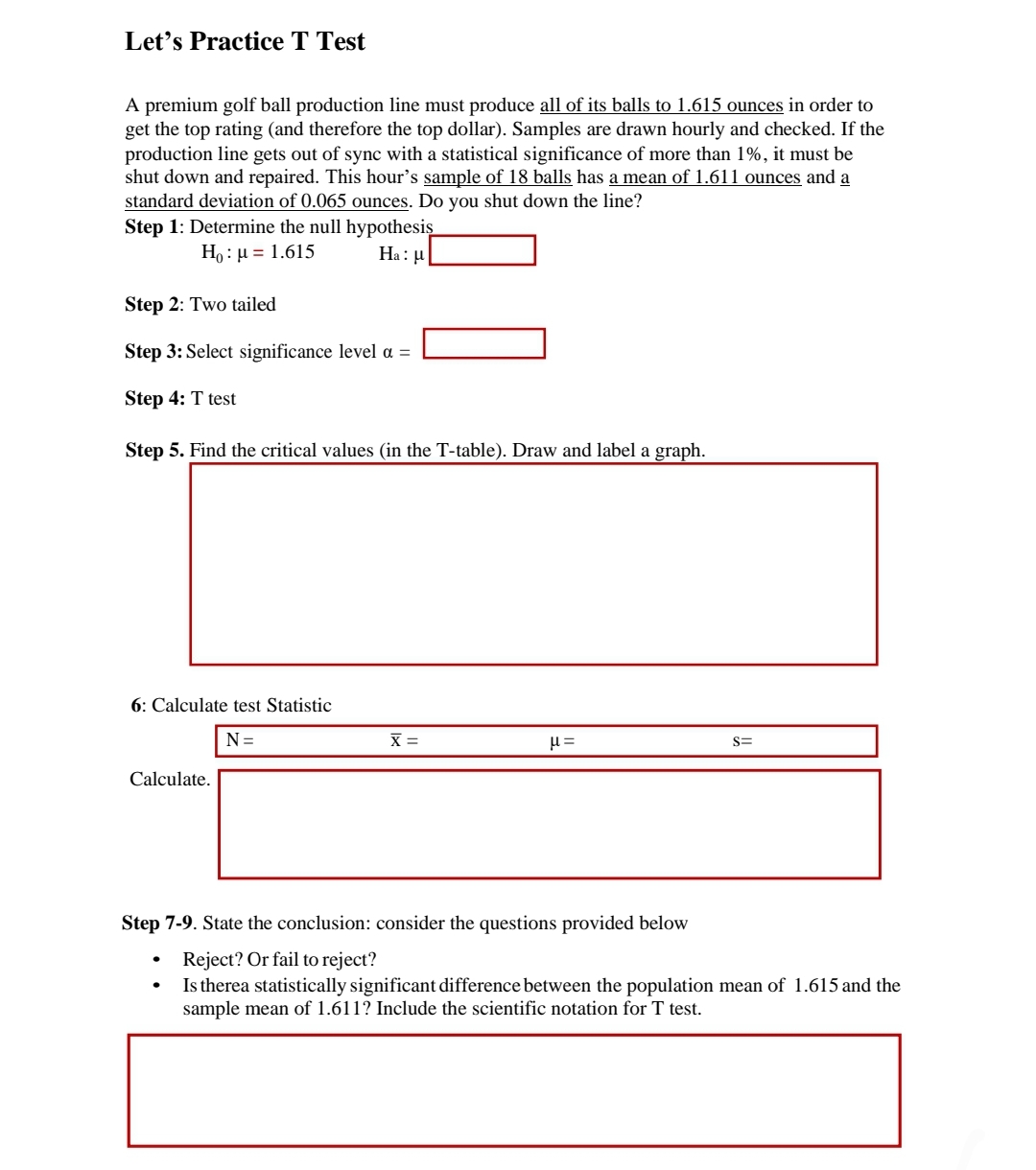Let's Practice T Test A premium golf ball production line must produce all of its balls to 1.615 ounces in order to get the top rating (and therefore the top dollar). Samples are drawn hourly and checked. If the production line gets out of sync with a statistical significance of more than 1%, it must be shut down and repaired. This hour's sample of 18 balls has a mean of 1.611 ounces and a standard deviation of 0.065 ounces. Do you shut down the line? Step 1: Determine the null hypothesis Ho: µ = 1.615 Ha: H Step 2: Two tailed Step 3: Select significance level a = Step 4: T test Step 5. Find the critical values (in the T-table). Draw and label a graph. 6: Calculate test Statistic N= X = Calculate. Step 7-9. State the conclusion: consider the questions provided below Reject? Or fail to reject? Is therea statistically significant difference between the population mean of 1.615 and the sample mean of 1.611? Include the scientific notation for T test.
Let's Practice T Test A premium golf ball production line must produce all of its balls to 1.615 ounces in order to get the top rating (and therefore the top dollar). Samples are drawn hourly and checked. If the production line gets out of sync with a statistical significance of more than 1%, it must be shut down and repaired. This hour's sample of 18 balls has a mean of 1.611 ounces and a standard deviation of 0.065 ounces. Do you shut down the line? Step 1: Determine the null hypothesis Ho: µ = 1.615 Ha: H Step 2: Two tailed Step 3: Select significance level a = Step 4: T test Step 5. Find the critical values (in the T-table). Draw and label a graph. 6: Calculate test Statistic N= X = Calculate. Step 7-9. State the conclusion: consider the questions provided below Reject? Or fail to reject? Is therea statistically significant difference between the population mean of 1.615 and the sample mean of 1.611? Include the scientific notation for T test.
Glencoe Algebra 1, Student Edition, 9780079039897, 0079039898, 2018
18th Edition
ISBN:9780079039897
Author:Carter
Publisher:Carter
Chapter10: Statistics
Section10.3: Measures Of Spread
Problem 1GP
Related questions
Question
A premium golf ball production line must produce all of its balls to 1.615 ounces in order to
get the top rating (and therefore the top dollar). Samples are drawn hourly and checked. If the
production line gets out of sync with a statistical significance of more than 1%, it must be
shut down and repaired. This hour’s sample of 18 balls has a
standard deviation of 0.065 ounces. Do you shut down the line?
Step 1: Determine the null hypothesis
H0 : μ = 1.615 Ha : μ

Transcribed Image Text:Let's Practice T Test
A premium golf ball production line must produce all of its balls to 1.615 ounces in order to
get the top rating (and therefore the top dollar). Samples are drawn hourly and checked. If the
production line gets out of sync with a statistical significance of more than 1%, it must be
shut down and repaired. This hour's sample of 18 balls has a mean of 1.611 ounces and a
standard deviation of 0.065 ounces. Do you shut down the line?
Step 1: Determine the null hypothesis
Ho: µ = 1.615
Ha: µ
Step 2: Two tailed
Step 3: Select significance level a =
Step 4: T test
Step 5. Find the critical values (in the T-table). Draw and label a graph.
6: Calculate test Statistic
N=
X =
S=
Calculate.
Step 7-9. State the conclusion: consider the questions provided below
Reject? Or fail to reject?
Is therea statistically significant difference between the population mean of 1.615 and the
sample mean of 1.611? Include the scientific notation for T test.
Expert Solution
This question has been solved!
Explore an expertly crafted, step-by-step solution for a thorough understanding of key concepts.
This is a popular solution!
Trending now
This is a popular solution!
Step by step
Solved in 2 steps with 1 images

Recommended textbooks for you

Glencoe Algebra 1, Student Edition, 9780079039897…
Algebra
ISBN:
9780079039897
Author:
Carter
Publisher:
McGraw Hill

College Algebra (MindTap Course List)
Algebra
ISBN:
9781305652231
Author:
R. David Gustafson, Jeff Hughes
Publisher:
Cengage Learning

Glencoe Algebra 1, Student Edition, 9780079039897…
Algebra
ISBN:
9780079039897
Author:
Carter
Publisher:
McGraw Hill

College Algebra (MindTap Course List)
Algebra
ISBN:
9781305652231
Author:
R. David Gustafson, Jeff Hughes
Publisher:
Cengage Learning